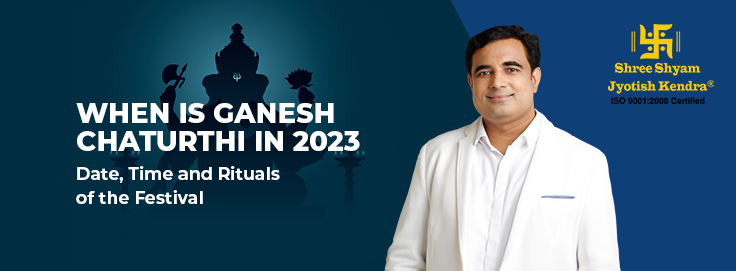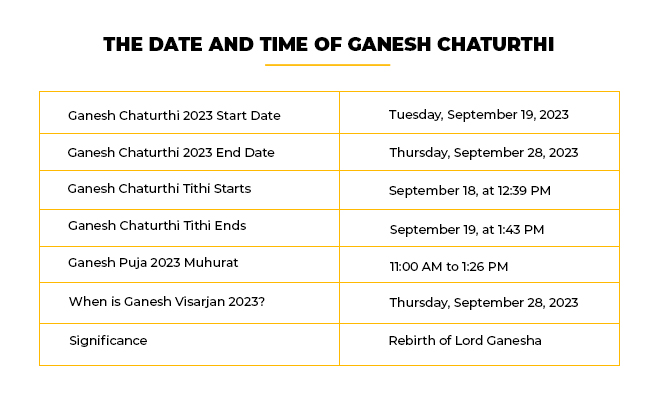
Ganesh Chaturthi is among the most widely celebrated religious festivals in our country. Indians have revered Lord Ganesha for generations and the day to honor him has been a staple since time immemorial. The festival is now merely a month away. With the occasion just around the corner, let’s take a look at just why we celebrate Ganesh Chaturthi and how one should make the most of this auspicious day.
The Date and Time of Ganesh Chaturthi

The Origin and History of Ganesh Chaturthi
In Hindu mythology, Lord Ganesha is the son of the deities Lord Shiva and the Goddess Parvati. It’s the very story of his birth to which the foundational myth of the festival can be ascribed. While taking a bath, Goddess Parvati carved a figure out of clay that could guard the entrance to her chambers. The clay figure was infused with life and named Ganesha. The little boy guarded diligently, preventing even Lord Shiva from entering. This caused the two to engage in a battle. Lord Shiva remained unrelenting and struck the little boy of clay with his renowned trident. Ganesha was decapitated immediately.
Goddess Parvati was horrified to see the son that she’d carved out of her very hands meet such a mortifying end. To please his wife, Lord Shiva instructed his legion of followers to embark on a journey and bring back the head of the first creature they found. Lo and behold, the followers encountered an elephant. Goddess Parvati, adept at sorcery and enchantment, affixed the elephant head atop her son and Lord Ganesha became the figure we know today.

The festival has been a staple of Hindu traditions since the age of antiquity. But, modern practices can be traced to the Maratha Empire. Chhatrapati Shivaji wished to strengthen his people, and establishing a tangible Maratha identity was a part of this process. Emphasizing religious traditions became of priority, and Lord Ganesha was recognized as the foremost deity of the Marathas. This idea remained relevant for centuries before experiencing a lull when the British Empire gained a foothold in the country. Seeking to revitalize both Maharashtrian and Indian identities through faith, social reformer, and freedom fighter Bal Gangadhar Tilak promoted Ganesh Chaturthi as a way to push back against colonial cultural assertions.
The Significance of Ganesh Chaturthi
As aforementioned, celebrating Ganesh Chaturthi is deeply significant to the people of India and Hindus around the world. Devotees honor Lord Ganesha for the blessings he bestows upon the many facets of their life:
- Lord Ganesha is regarded as the remover of obstacles. As such, devotees pray that he can help them clear a path toward peace and prosperity in life.
- Similarly, Hindus also look to Lord Ganesha for blessings before the commencement of any new endeavor. Ganesh Chaturthi marks another occasion where this is done, this time to hope for an auspicious remainder of the year.
- As attested by the acts of both Chhatrapati Shivaji and Bal Gangadhar Tilak, Lord Ganesha brings unity to a community. Prayers for fostering peace are directed at the deity during his festival.
- Since Lord Ganesha possesses the head of an elephant, he is often also associated with the protection of the environment. Conscious devotees use the festival to promote eco-friendliness.
- Lord Ganesha is also perceived by many as a deity of personal growth. Reflecting on one’s life and purpose with his blessings is regarded as an essential part of Ganesh Chaturthi festivities.
- Finally, citizens across the country pay homage to Lord Ganesha during his day of celebration as a form of gratitude for his role in fostering a nationalistic spirit.
The Rituals of Ganesh Chaturthi
There are a variety of rituals associated with Ganesh Chaturthi. Of course, the festival has been an auspicious occasion for thousands of years, and has a list of customs that have remained central throughout.
Pran Pratishtha
The term refers to a ceremony where a deity’s murti is consecrated. As mentioned earlier, conscious devotees of Lord Ganesha seek to be eco-friendly, and hence idols are carved from biodegradable materials. Some also choose clay to pay homage to the foundational myth. Goddess Parvati’s contributions are again acknowledged as devotees symbolically infuse life into the idol before them.
Bathing the idol
Subsequently, the idol of Lord Ganesha is given a purifying bath during a ritual often known as Sankalp. In the observance of this ritual, one initiates by arranging five flowers as an offering to establish a seat for Lord Ganesha. Water is employed to cleanse the feet of Lord Ganesha’s idol, symbolizing both reverence and purification. A gesture of homage is extended through the presentation of water as an offering to the benevolent deity. Following this, the idol is bathed with pristine water, preferably Gangajal, thereby bestowing sanctity upon its presence. Moving forward, a second bathing ritual named Panchamrit is conducted, involving a mixture of ghee, milk, sugar, honey, and curd, as a gesture to honor and invoke blessings from Lord Ganesha.
Offerings
This is known as naivedya. It refers to offerings made to Lord Ganesha as a measure of gratitude and devotion. The sequence begins with adorning Lord Ganesha in fresh attire and Moli, accompanied by the presentation of Yajnopavita. Subsequent steps involve the offering of incense sticks, rice grains, and flowers to Lord Ganesha, followed by the presentation of Naivedya, which consists of offerings of food. Following the Naivedya offering, the ritual continues with the application of sandalwood paste, the offering of paan with betel nuts, a coconut, and Dakshina. This meticulously ordered series of rituals showcases a comprehensive and reverential approach to the worship of Lord Ganesha.
Aarti
During the Ganesh Chaturthi aarti, devotees gather around the idol of Lord Ganesha. A lighted lamp with multiple wicks is waved before the idol, symbolizing the removal of darkness and the divine presence. Camphor is lit and circled in front of the idol while singing a devotional hymn. This aarti song praises Lord Ganesha’s qualities and blessings. Devotees often raise their hands toward the flame and then touch their eyes and head. After the aarti, the blessed camphor or prasad is distributed. The aarti signifies unity, devotion, and a moment of personal reflection in the celebration of Ganesh Chaturthi.
Avoiding the moon
On Ganesh Chaturthi, it is strongly advised not to observe the moon, as doing so is believed to attract a curse known as Mithya dosham or Mithya kalank, associated with false accusations of theft. The specific period to avoid moon sighting is from 09:16 to 21:05, spanning 11 hours and 48 minutes. Should an individual mistakenly witness the moon on this occasion, they can chant the following mantra to counter the curse: “सिंहः प्रसेनमवधीत्सिंहो जाम्बवता हतः। सुकुमारक मारोदीस्तव ह्येष स्यमन्तकः॥”
Conclusion
In conclusion, Ganesh Chaturthi 2023 is set to be a vibrant and deeply spiritual celebration that honors the birth of Lord Ganesha, the remover of obstacles and bestower of wisdom. As devotees come together to install intricately crafted idols, offer heartfelt prayers, and engage in joyous festivities, the festival’s significance goes beyond religious boundaries, fostering unity, cultural expression, and environmental awareness. Amidst the melodies of aartis, the fragrance of incense, and the spirit of togetherness, Ganesh Chaturthi serves as a timeless reminder of the power of faith, devotion, and the ability to overcome challenges.
Looking for astrological insights this Ganesh Chaturthi? Consult Pt. Pawan Kaushik, the best astrologer in India, for expert guidance and predictions today. He has more than 3 decades of experience and has touched the lives of 1M+ people.
Discover the power of celestial wisdom with the best in the field. Schedule your consultation now and embark on a journey of enlightenment.
 +91 9990176000
+91 9990176000 +91 9999097600
+91 9999097600
 CALENDAR 2024
CALENDAR 2024










